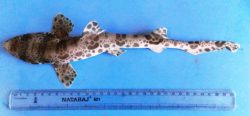select your film:


Magnificent Catsharks are only known from five specimens that were collected in the northern part of the Andaman Sea near the edge of the Myanmar continental shelf. They can be found in the Eastern Indian Ocean at depths of 140 m near Myanmar.
Biology and Behaviour:
Magnificent catsharks are slender finback sharks that have an elaborate colour pattern of small and large dark spots on its back. They have a flattened head, a large lobe of skin in front of each nostril that give them a bell-shaped snout. Their large oval eyes have a nictitating membrane — protective eyelid — and their mouth forms a long, wide arch with short furrows at the corners. The upper teeth are exposed when their mouths are closed, and there are over 80 tooth rows in the upper jaw. They have five pairs of gill slits.
The first dorsal fin is a little larger than the second dorsal fin. The pectoral fin is larger and broader than the pelvic fins, but both have rounded tips. The caudal fin is short. Their two dorsal fins are triangular with rounded apexes and gently concave at the edges.
They can reach 49 cm in length.
Reproduction and Lifespan:
There is currently no information on the reproduction and lifespan of Magnificent Catsharks.
Conservation and Tourism:
Magnificent Catsharks have not yet been evaluated for the IUCN Red List.
Do you have images or videos of Magnificent Catsharks?
Submit them to [email protected].
